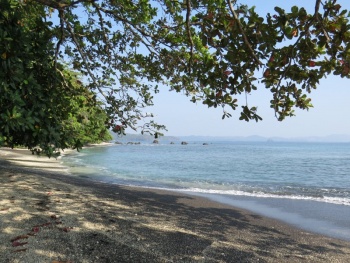Overview
Tangkoko (officially Tangkoko-Batuangus Dua Saudara) is a nature reserve in northern Sulawesi. It covers around 8,700 hectares. Three mountains are inside the reserve: Mount Tangkoko, Mount Dua Saudara and Mount Batuangus.
The accessible parts of the park consist of dry old secondary forest. Several endemics and difficult to find species can be found here.
Birds
Notable Species
Tangkoko is probably the easiest place to see Red-backed Thrush, Sulawesi Pitta, Ochre-bellied Boobook, Sulawesi Dwarf Kingfisher, Sulawesi Nightjar or White-rumped Cuckooshrike. Knobbed Hornbill and Sulawesi Hornbill are more common than in other parts of the island. Other species like Minahasa Masked Owl occur but you need luck to see them.
Check-list
Birds you can see here include:
Lesser Frigatebird, Great-billed Heron, Purple Heron, Little Egret, Eastern Cattle Egret, Striated Heron, Osprey, Brahminy Kite, White-bellied Sea Eagle, Chinese Goshawk, Sulawesi Goshawk, Japanese Sparrowhawk, Spot-tailed Goshawk, Sulawesi Hawk Eagle, Philippine Megapode, Red Junglefowl, Isabelline Bush-hen, Pacific Golden Plover, Whimbrel, Common Sandpiper, Grey-tailed Tattler, Whiskered Tern, Brown Cuckoo Dove, Pink-necked Green Pigeon, Grey-cheeked Green Pigeon, Grey-headed Imperial Pigeon, Black-naped Fruit Dove, Silver-tipped Imperial Pigeon, Ornate Lorikeet, Blue-backed Parrot, Sulawesi Hanging Parrot, Bay Coucal, Black-billed Koel, Sulawesi Masked Owl, Minahasa Masked Owl, Sulawesi Scops Owl, Ochre-bellied Boobook, Speckled Boobook, Great Eared Nightjar, Sulawesi Nightjar, Uniform Swiftlet, Glossy Swiftlet, Grey-rumped Treeswift, Green-backed Kingfisher, Sulawesi Lilac Kingfisher, Great-billed Kingfisher, Ruddy Kingfisher, Collared Kingfisher, Sacred Kingfisher, Sulawesi Dwarf Kingfisher, Rainbow Bee-eater, Purple-winged Roller, Sulawesi Hornbill, Knobbed Hornbill, Sulawesi Pygmy Woodpecker, Ashy Woodpecker, Sulawesi Pitta, Hooded Pitta, Barn Swallow, Pacific Swallow, Pied Cuckooshrike, White-rumped Cuckooshrike, Sooty-headed Bulbul, Hair-crested Drongo, Black-naped Oriole, Slender-billed Crow, Sulawesi Babbler, Red-backed Thrush, Golden-bellied Gerygone, Pale-blue Monarch, Grey-streaked Flycatcher, Ivory-backed Woodswallow, Finch-billed Myna, White-necked Myna, Brown-throated Sunbird, Olive-backed Sunbird, Black-fronted White-eye, Eurasian Tree Sparrow
Other Wildlife
Sulawesi Crested Macaque is often found around the beach. The guides also know places to see Gurky's Tarsier and if you are lucky you may find a Bear Cuscus. Sulawesi Dwarf Squirrels are common, as are their ringing alarm calls. Rusa deer are introduced.
Plants
The park boasts many impressive strangler figs (Ficus benjamina) and has been colonised by invasive alien African Tulip trees (Spathodea campanulata).
Site Information
History and Use
The Dutch created the reserve in 1919. It was later enlarged. Most of the lowland forest has been partially logged. Hunting and bird trapping still takes place.
Areas of Interest
Forest behind Tangkoko Beach
A network of paths leads into the forest from the beach. The dry forest has little undergrowth and many species are easier to find here than elsewhere. Watch out for Red-backed Thrush, Sulawesi Pitta and Philippine Megapode in early morning. The guides can also lead you to the daytime roost of Ochre-bellied Boobook and they may find you a Sulawesi Dwarf Kingfisher. Green-backed Kingfisher and Sulawesi Lilac Kingfisher occur too.
Open areas near park entrance
Look out here for the endemic White-rumped Cuckooshrike, Purple-winged Roller and raptors.
Mangroves north of Batuputih
The guides or your accomodation can arrange an early morning (or late afternoon) boat trip from Batuputih to the mangroves. Great-billed Kingfisher is probably the star bird here. Great-billed Heron occurs at the beach, Grey-tailed Tattler spends the winter here and Rainbow Bee-eaters and Pink-necked Green Pigeons fly overhead.
Access and Facilities
The reserve can be reached by road from Manado, the biggest city in northern Sulawesi. Manado has an airport with domestic and a few international flights. Various Manado tour operators can organise trips to Tangkoko.
There is accommodation nearby, most of it along the road to Batuputih. In Batuputih and at the park entrance various lodges and guides advertise their services. Good bird guides charge quite a lot but are usually worth the money. Cheaper guides often don't know the birds and are known to poke Tarsiers with sticks for better pictures. Don't encourage behaviour like this.
Tangkoko is infamous for its biting arthropods. Likely a type of mite, these attack the ankles resulting in severe itching which subsides only slowly. Use an appropriate repellent !
External Links






